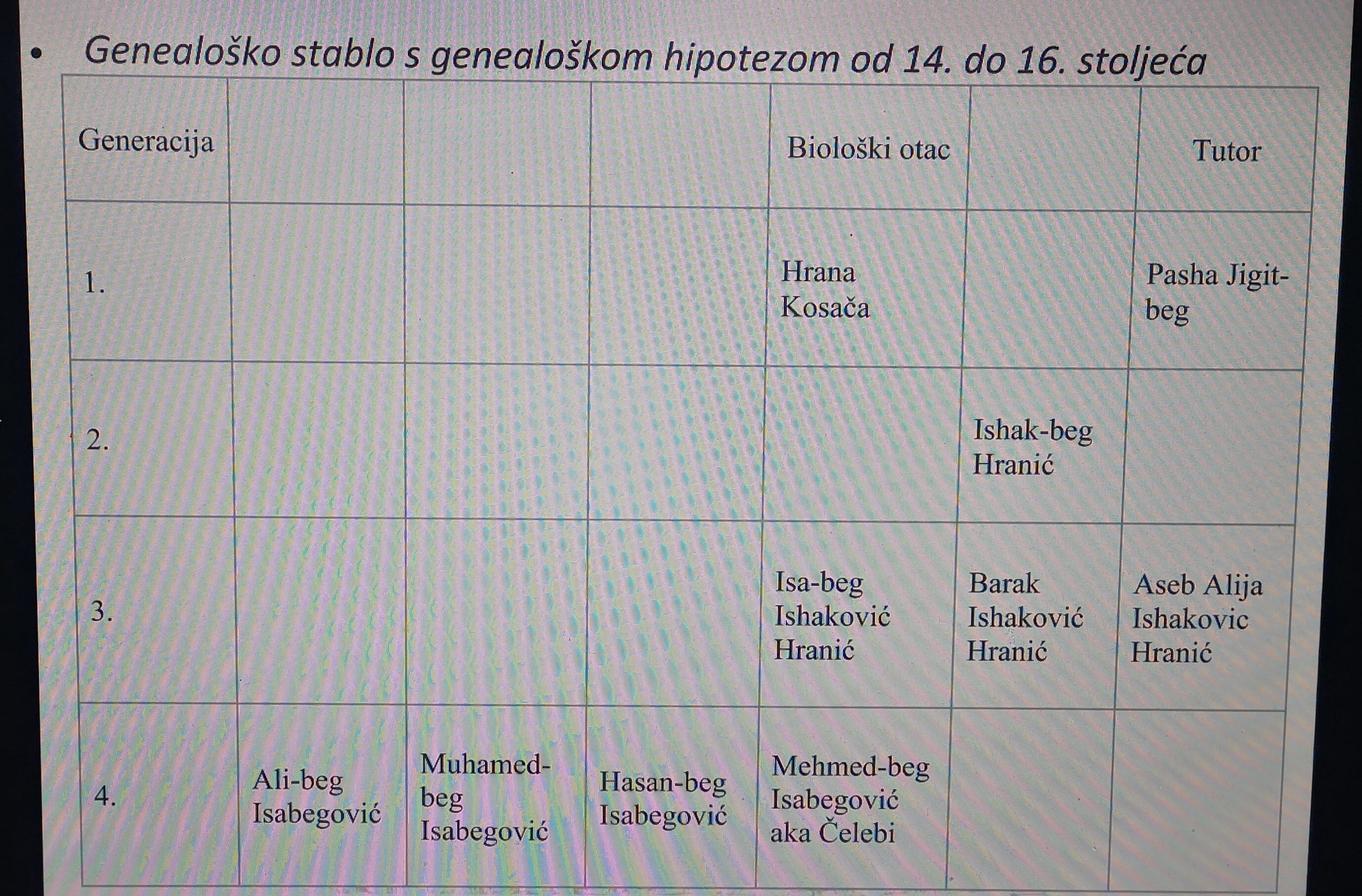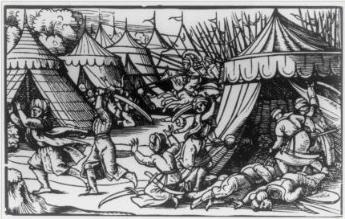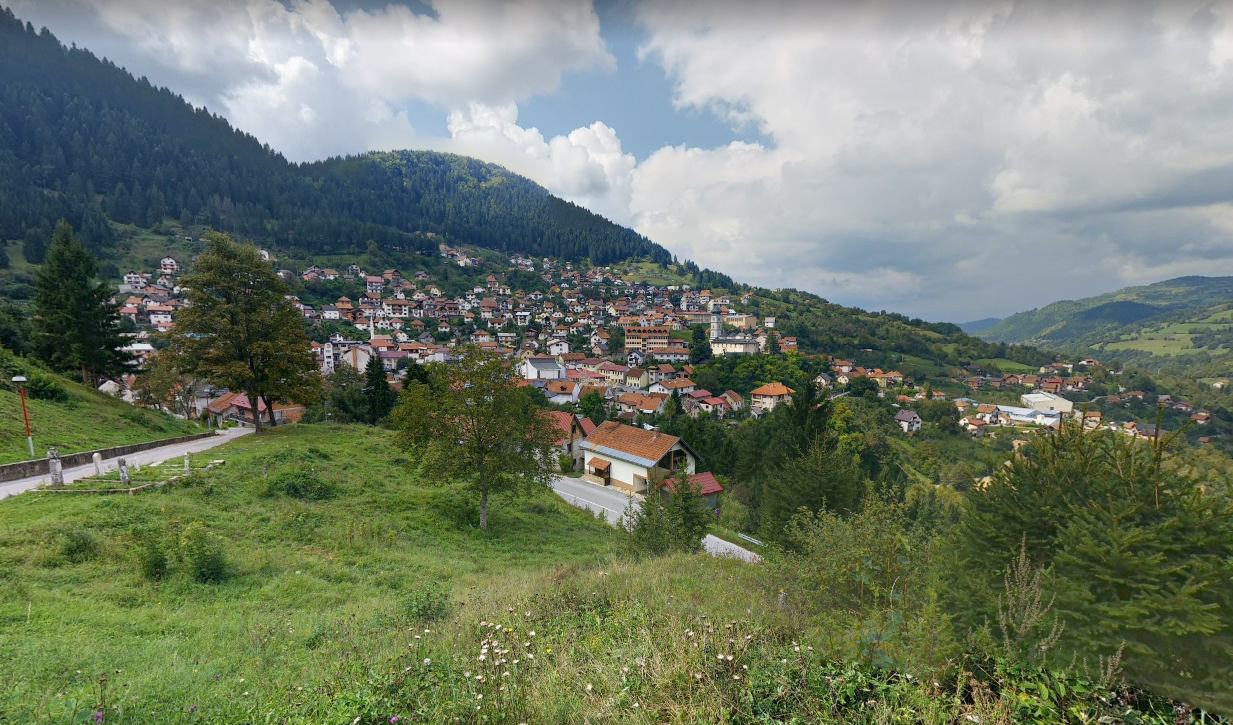|
Isak-Beg
Ishak Bey or Ishak-Beg or Ishak-Beg Hranić was an Ottoman governor and soldier, the sanjakbey of Üsküb from 1415 to 1439. Biography According to some sources he was a member of the Bosnian Hranušić family, released slave and adopted son of Pasha Yiğit Bey. It is very possible that in the spirit of the customs of the time, his brother Sandalj Hranić sent him to the sultan's court as a political and diplomatic move as a sign of loyalty to the emperor. His biological father was Hrana Vuković, his full name is Ishak Bey Hranić and according to whom Ishak's most famous son Isa Bey, along with his father's and grandfather's patronymic, will be - Isa Bey Ishaković Hranušić. Ishak Bey is the founder of the Ottoman branch of the aristocratic Bosnian Kosača - Isabegović family. Ishak was appointed ruler by Porte at the time of the conquest of Foča, Čajniče, Pljevlja and Nevesinje in today's Bosnia and Herzegovina. In 1420 Ishak Bey organized a successful private ca ... [...More Info...] [...Related Items...] OR: [Wikipedia] [Google] [Baidu] |
Gjon Kastrioti
Gjon Kastrioti (1375/80 – 4 May 1437), was a member of the Albanian nobility, from the House of Kastrioti, and the father of future Albanian leader Gjergj Kastrioti (better known as Skanderbeg). He governed the territory between the Cape of Rodon and Dibër and had at his disposal an army of 2,000 horsemen. Early life The Kastrioti family was from a region of northern Albania between Mat, Dibër and Has. Konstantin Kastrioti Mazreku is attested in Giovanni Andrea Angelo Flavio Comneno's ''Genealogia diversarum principum familiarum''. Angelo mentions Kastrioti as ''Constantinus Castriotus, cognomento Meserechus, Aemathiae & Castoriae Princeps'' (Constantinus Castriotus, surnamed Meserechus, Prince of Aemathia and Castoria). Angelo used the cognomen ''Meserechus'' in reference to Skanderbeg and this link to the same name is produced in other sources and reproduced in later ones like Du Cange's ''Historia Byzantina'' (1680). These links highlight that the Kastrioti used Mazr ... [...More Info...] [...Related Items...] OR: [Wikipedia] [Google] [Baidu] |
Battle Of Albulena
The Battle of Albulena, also known as the Battle of Ujëbardha, was fought on 2 September 1457 between Albanian forces led by Skanderbeg and an Ottoman army under Isak bey Evrenoz and Skanderbeg's nephew, Hamza Kastrioti. Skanderbeg had been the leader of the Albanians for over a decade and had seen many victories over Ottoman arms. However, after his loss at Berat in 1455 at the hands of Isak bey, Skanderbeg was betrayed by some of his most trusted officers, among them Moisi Arianit Golemi. Golemi returned the next year with an Ottoman force under his command, but was defeated at the Battle of Oranik and rejoined Skanderbeg's army. Later, the dissatisfied Hamza Kastrioti betrayed Skanderbeg and was offered joint-command with Isak bey over a second Ottoman invasion force. The Ottomans arrived in late May 1457 and marched through the Mat River Valley. Skanderbeg tried to delay the vanguard, composed of Akıncı cavalrymen, but upon the approach of the main force, decided t ... [...More Info...] [...Related Items...] OR: [Wikipedia] [Google] [Baidu] |
Battle Of Niš (1443)
The Battle of Niš (early November, 1443) saw crusaders led by John Hunyadi and Đurađ Branković capture the Ottoman stronghold of Niš in Serbia, and defeat three armies of the Ottoman Empire. The Battle of Niš was part of Hunyadi's expedition known as the ''long campaign''. Hunyadi, at the head of the vanguard, crossed the Balkans through the Gate of Trajan, captured Niš, defeated three Turkish pashas, and after taking Sofia, united with the royal army and defeated Sultan Murad II at Snaim (Kustinitza). The impatience of the king and the severity of the winter then compelled him (in February 1444) to return home. Background In 1440 John Hunyadi became the trusted adviser and most highly regarded soldier of king Władysław III of Poland. Hunyadi was rewarded with the captaincy of the fortress of Belgrade and was put in charge of military operations against the Ottomans. King Władysław recognized Hunyadi's merits by granting him estates in Eastern Hungary. Hunyadi soon ... [...More Info...] [...Related Items...] OR: [Wikipedia] [Google] [Baidu] |
Siege Of Berat (1455)
The siege of Berat took place in July 1455 when the Albanian army of Skanderbeg besieged the fortress in the Albanian city of Berat, which was held by Ottoman forces. Background When Skanderbeg began his rebellion, Berat belonged to the Albanian prince Theodore Muzaka. When in 1449 Theodore Muzaka was dying, he sent for Skanderbeg to take over the castle in the name of the League of Lezhë. Skanderbeg sent an Albanian detachment led by Pal Kuka, to claim the castle. In the meantime a force of Ottoman soldiers came from their garrison in Gjirokastër, quietly scaled the poorly guarded walls of Berat at night, slaughtered the Albanian garrison of about 500 soldiers, hanged the dying Theodore Muzaka, and claimed the castle, while the captain Pal Kuka was later ransomed.Fan Stylian Noli, 1947 Berat was located on an important strategic position as it controlled much of southern Albania as well as the vital supply routes leading to southern Macedonia and Greece. Siege Skand ... [...More Info...] [...Related Items...] OR: [Wikipedia] [Google] [Baidu] |
Čajniče
Čajniče ( sr-cyr, Чајниче, ) is a town and municipality located in Republika Srpska, an entity of Bosnia and Herzegovina. As of 2013, the town has a population of 2,401 inhabitants, while the municipality has 4,895 inhabitants. Settlements Aside from the town of Čajniče, the municipality includes the following settlements: * Avlija * Batkovići * Batotići * Batovo * Bezujno * Borajno * Brezovice * Bučkovići na Bezujanci * Đakovići * Glamočevići * Gložin * Hunkovići * Ifsar * Kamen * Kapov Han * Karovići * Krstac * Lađevci * Luke * Međurječje * Metaljka * Milatkovići * Miljeno * Mištar * Podavrelo * Ponikve * Prvanj * Slatina * Staronići * Stopići * Sudići * Todorovići * Trpinje * Tubrojevići * Zaborak Demographics Population Ethnic composition Notable people * Hanka Paldum Hanka Paldum (born 28 April 1956) is a Bosnian sevdalinka singer and founder of the record label Sarajevo Disk. She is regarded as one ... [...More Info...] [...Related Items...] OR: [Wikipedia] [Google] [Baidu] |
Pljevlja
Pljevlja ( srp, Пљевља, ) is a town and the center of Pljevlja Municipality located in the northern part of Montenegro. The town lies at an altitude of . In the Middle Ages, Pljevlja had been a crossroad of the important commercial roads and cultural streams, with important roads connecting the littoral with the Balkan interior. In 2011, the municipality of Pljevlja had a population of 30,786, while the city itself had a population of about 19,489 making it the fourth largest urban settlement in Montenegro. The municipality borders those of Žabljak, Bijelo Polje and Mojkovac in Montenegro, as well as Bosnia and Herzegovina to the west and Serbia to the northeast. With a total area of , it is the third largest municipality in Montenegro. History Prehistory and antiquity The first traces of human life in the region date between 50,000 and 40,000 BC, while reliable findings show that the Ćehotina River valley was inhabited no later than 30,000 BC. The oldest traces of hum ... [...More Info...] [...Related Items...] OR: [Wikipedia] [Google] [Baidu] |
Nevesinje
Nevesinje ( sr-cyrl, Невесиње) is a town and municipality located in the Republika Srpska entity of Bosnia and Herzegovina. As of 2013, the town has a population of 5,162 inhabitants, while the municipality has 12,961 inhabitants. Geography and climate Geography The municipality of Nevesinje covers and is located in southern part of Bosnia and Herzegovina. A large polje called Nevesinjsko polje dominates the municipality, and is encircled by mountains of Crvanj at the north-northeast, Prenj at the northwest, and Velež (Bosnia and Herzegovina), Velež at the south-southwest. The entire municipality, as well as the entire region of eastern Herzegovina beyond municipal borders, is an elevate at the average above the sea level. History The annals of the Patriarchal Monastery of Peć mentioned Nevesinje in 1219, which is the earliest appearance of Nevesinje in preserved historical sources. The ''župa'' (county) of Nevesinje was held by Serbian prince Stefan Konstantin betw ... [...More Info...] [...Related Items...] OR: [Wikipedia] [Google] [Baidu] |
Bosnia And Herzegovina
Bosnia and Herzegovina ( sh, / , ), abbreviated BiH () or B&H, sometimes called Bosnia–Herzegovina and often known informally as Bosnia, is a country at the crossroads of south and southeast Europe, located in the Balkans. Bosnia and Herzegovina borders Serbia to the east, Montenegro to the southeast, and Croatia to the north and southwest. In the south it has a narrow coast on the Adriatic Sea within the Mediterranean, which is about long and surrounds the town of Neum. Bosnia, which is the inland region of the country, has a moderate continental climate with hot summers and cold, snowy winters. In the central and eastern regions of the country, the geography is mountainous, in the northwest it is moderately hilly, and in the northeast it is predominantly flat. Herzegovina, which is the smaller, southern region of the country, has a Mediterranean climate and is mostly mountainous. Sarajevo is the capital and the largest city of the country followed by Banja Luka, Tu ... [...More Info...] [...Related Items...] OR: [Wikipedia] [Google] [Baidu] |
1420
Year 1420 ( MCDXX) was a leap year starting on Monday (link will display the full calendar) of the Julian calendar. Events January–December * March – The Çelebi Sultan Mehmed Mosque in Didymoteicho is inaugurated. * May 21 – Treaty of Troyes: With the Burgundian faction dominant in France, King Charles VI of France acknowledges Henry V of England as his heir, and as virtual ruler of most of France. * May 25 – Henry the Navigator is appointed governor of the Portuguese Order of Christ. * June 2 – Catherine of Valois marries King Henry V of England. * June 7 – Troops of the Republic of Venice capture Udine after a long siege, ending the independence of the Patriarchal State of Friuli, run by the Patriarch of Aquileia. * August 7 – Construction of the dome of Florence Cathedral is started, after Filippo Brunelleschi wins the commission for his "double shell" design. * September 1 – a 9.4 MS-strong earthquake shakes Chile's A ... [...More Info...] [...Related Items...] OR: [Wikipedia] [Google] [Baidu] |
Skopje
Skopje ( , , ; mk, Скопје ; sq, Shkup) is the capital and largest city of North Macedonia. It is the country's political, cultural, economic, and academic centre. The territory of Skopje has been inhabited since at least 4000 BC; remains of Neolithic settlements have been found within the old Kale Fortress that overlooks the modern city centre. Originally a Paeonian city, Scupi became the capital of Dardania in the second century BC. On the eve of the 1st century AD, the settlement was seized by the Romans and became a military camp. When the Roman Empire was divided into eastern and western halves in 395 AD, Scupi came under Byzantine rule from Constantinople. During much of the early medieval period, the town was contested between the Byzantines and the Bulgarian Empire, whose capital it was between 972 and 992. From 1282, the town was part of the Serbian Empire, and acted as its capital city from 1346 to 1371. In 1392, Skopje was conquered by the Ottoman Turks ... [...More Info...] [...Related Items...] OR: [Wikipedia] [Google] [Baidu] |
Siege Of Thessalonica (1422–1430)
The siege of Thessalonica between 1422 and 1430 saw the Ottoman Empire, under Sultan Murad II, capture the city of Thessalonica, which remained in Ottoman hands for the next five centuries, until it became part of the Kingdom of Greece in 1912. Thessalonica had already been under Ottoman control from 1387 to 1403 before returning to Byzantine rule in the aftermath of the Battle of Ankara. In 1422, after the Byzantines supported Mustafa Çelebi as a rival pretender against him, Murad attacked Thessalonica. Unable to provide manpower or resources for the city's defense, its ruler, Andronikos Palaiologos, handed it over to the Republic of Venice in September 1423. The Venetians attempted to persuade the Sultan to recognize their possession, but failed as Murad considered the city his by right and the Venetians to be interlopers. This impasse led to an Ottoman blockade of Thessalonica, which occasionally flared up with direct attacks on the city. At the same time, the conflict was ... [...More Info...] [...Related Items...] OR: [Wikipedia] [Google] [Baidu] |
Ottoman Porte
The Sublime Porte, also known as the Ottoman Porte or High Porte ( ota, باب عالی, Bāb-ı Ālī or ''Babıali'', from ar, باب, bāb, gate and , , ), was a synecdoche for the central government of the Ottoman Empire. History The name has its origins in the old practice in which the ruler announced his official decisions and judgements at the gate of his palace. This was the practice in the Byzantine Empire and it was also adopted by Ottoman Turk sultans since Orhan I, and therefore the palace of the sultan, or the gate leading to it, became known as the "High Gate". This name referred first to a palace in Bursa, Turkey. After the Ottomans had conquered Constantinople, now Istanbul, the gate now known as the Imperial Gate ( tr, Bâb-ı Hümâyûn), leading to the outermost courtyard of the Topkapı Palace, first became known as the "High Gate", or the "Sublime Porte". When Sultan Suleiman the Magnificent sealed an alliance with King Francis I of France in 1536, the ... [...More Info...] [...Related Items...] OR: [Wikipedia] [Google] [Baidu] |







